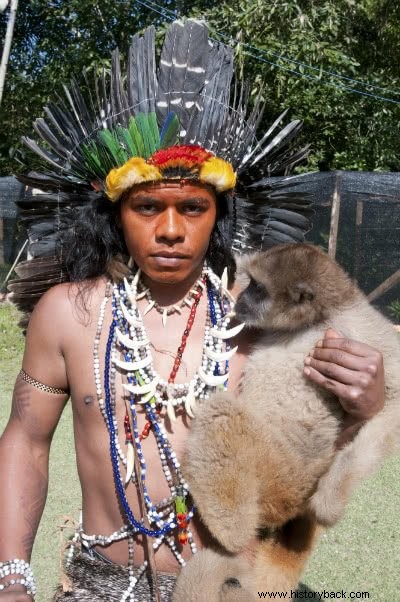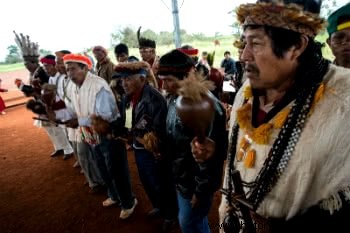The Guarani Indians form the largest native people, in terms of number of individuals, living in Brazil.
They originate from the trunk of the Tupi-Guarani linguistic family.
Where do the Guarani live?
In Brazil, the Guarani live in the Brazilian states of Mato Grosso do Sul, São Paulo, Paraná, Rio Grande do Sul, Rio de Janeiro, Espírito Santo, Pará, Santa Catarina and Tocantins.
In the country alone, there are 57 thousand people, according to the IBGE (Brazilian Institute of Geography and Statistics).
There are also indigenous Guarani people living in Argentina, Bolivia and Paraguay. Most Guarani live in Bolivia, where there are 78,300 individuals. In Paraguay, there are 41,200 and in Argentina, 6,500.
Characteristics of the Guarani Indians
The Guaraní are divided into Kaiowá, Mbya and ñadeva. They are known, depending on the place, as avá, chiripá, kainguá, monteses, baticola, apyteré and tembukuá.
The groups are internally differentiated by the way they manifest their culture, their social and political organization, their language, and also the way they practice their religion.
The Guaraní are gatherers and hunters. The physical space they inhabit is called tekoha, land, and they self-determine as the extension of the land they step on.

This concept is at the heart of most land disputes experienced by the Guarani people in Brazil.
Guarani culture
The Guarani Indians, also called the "great people", believe that they were created by Tupã to admire the land, through the word.
The first Guarani, Ñamandú, made the earth his bed.
Guarani language
The Guarani language belongs to the Tupi-Guarani linguistic branch, from which 21 languages derive.
The Jesuits learned the language to evangelize the natives and wrote grammars about the language, allowing its diffusion.
This is the most spoken indigenous language in South America and reaches 60% of Paraguay. The Mato Grosso do Sul border schools teach it at school.
See also:Tupi-Guarani CultureCustoms of the Guarani Indians
Social organization and songs are among the most evident cultural manifestations of the Guarani people. For them, the land, tekoha, is an integral part of the family.
Guaraní chants are sung as a way of demonstrating to the gods that they exist on earth.
His music is also used to control the forces of nature, such as lack or excess of rain. The songs are sung to the sound of gourds, transformed into musical instruments.
See also:Indigenous CultureHistory of the Guarani Indians
Migration is a natural process among the Guarani, as it allows for the renewal of the soil and guaranteeing their survival. The nomadic practice comes from its essentially extractive nature and has been going on for over 2,000 years.
This cultural trait was interrupted by colonization. After the arrival of Europeans, groups of Guarani began a migration process to escape attacks, murders and slavery.
With the occupation of the territory, however, there was no more place to migrate, although some groups still tend to persist.
In Mato Grosso do Sul, there are successive attacks on indigenous people, most of them being Mbya, Kaiowa and Nhandeva groups. In this state, the indigenous areas gave way to cattle ranches, soy and sugar cane.
The interruption of the migration process was accentuated after the Paraguayan War, which took place between 1864 and 1870.
At the end of the war, the territory was negotiated for occupation and to guarantee economic exploitation. Among the first products explored in the region is yerba mate, which is still widely consumed.
Between the 70's and 80's, the process of mechanization of crops begins, mainly soybean and sugarcane. Products are still the main commodities agriculture in the region.
Matte Larangeira Company
In 1882, the Brazilian government ceded the territory occupied by the Guarani for the implantation of yerba mate crops. The request was made by Thomas Larangeira, who founded the Matte Larangeira Company in 1892.
Forced to leave the territory, the indigenous people were affected by serious health problems and the social impact is still being felt.
Guarani indigenous reserves
The situation worsened in 1943, when President Getúlio Vargas (1882-1954) signed the decree creating the National Agricultural Colony of Dourados.
The purpose of the agency was to offer land to families of migrants from other regions and countries. It was yet another attempt to occupy the region in a movement that became known as the March to the West.
Successive displacement programs were implemented and resulted in forced migrations of the Guarani.
Between 1915 and 1928, the SPI (Indian Protection Service) demarcated eight lands to house the Guarani territory in the area that today corresponds to the state of Mato Grosso do Sul. The areas totaled 18.1 hectares.
The strategy was used so that, in a small area of territory, the indigenous people assimilated the surrounding culture (an anthropological term used to speak of the colonizer).
The maintenance of indigenous people in protected areas was altered by the imposition of monoculture in the region, in the 70's. Mato Grosso do Sul is one of the main soybean producers in the country.
This exploitation model results in the depletion of the land as a result of the use of pesticides and mechanization. Local biodiversity was altered and displacement of indigenous people continued.
The Kaiowá and Guarani Indians are among those who managed to resist, but were exploited.
In the 1980s, the federal government implemented Proálcool. The program's goal was to create supply and demand for biodiesel and help overcome the oil crisis.
In Mato Grosso do Sul, the Indians began to work in the sugarcane plantations. Cases of denunciation of the exploitation of slave labor were not rare.
In the 1980s, Guarani and Kaiowá regained possession of 11 traditional lands. Together, the areas total 22,400 hectares and ownership was ratified after the 1988 Constitution.
Anthropological studies indicate that there are more traditional lands belonging to indigenous peoples. The end of the dispute only occurs after the approval of the federal government. There is an impasse between indigenous people and landowners in the region.
As a result of the dispute, there are constant armed conflicts in the vicinity of the villages. Between 2003 and the first half of 2006, 400 Indians were murdered in the region.
The indigenous reserve in the city of Dourados (MS) covers 3,500 hectares. There are 12,000 individuals from different groups living there. Because they have different social elements, internal conflicts are not uncommon.

Learn more about:
- Brazilian Indians
- Brazilian Indigenous Art
